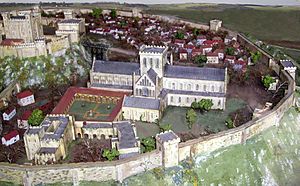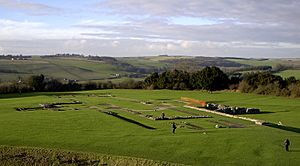Old Sarum Cathedral facts for kids
The Old Sarum Cathedral was a large Catholic church built by the Normans in England. It stood at a place called Old Sarum, which is now just foundations about 3 kilometers north of modern Salisbury, Wiltshire, in the United Kingdom. This cathedral was the main church for the bishops of Salisbury during the early Norman period (around 1092 to 1220). It was also where the "Sarum Rite" began, which was a special way of performing church services.
Contents
What the Old Sarum Cathedral Looked Like

At its biggest, the Norman cathedral was about 56 meters long. This was actually smaller than many other cathedrals being built at that time. It was shaped like a cross, which was a common design for churches.
The building had a long main hall called a nave, with seven sections supported by cross-shaped pillars. It also had a rounded end called an apse and a central tower where the nave and other parts of the church met. There were also several smaller chapels around the main building. Inside, the cathedral had six altars, including the main altar and others dedicated to saints like St Martin, St Nicholas, and St Stephen.
The History of Old Sarum Cathedral
How the Cathedral Started
After the Norman conquest of England in 1066, King William I used Old Sarum as an important base. It was a strong fortress built on a high hill. In 1075, a church leader named Herman was made bishop of this new area. He started building the cathedral soon after.
Herman died in 1078, and Saint Osmund became the next bishop. Osmund was King William's cousin. The cathedral was officially opened on April 5, 1092. However, just five days later, a big storm caused a lot of damage to the new building!
Rebuilding and Changes
After Osmund, there was a four-year gap before Roger of Salisbury became bishop. Roger rebuilt and made parts of the cathedral much bigger, finishing the work around 1120. He used green and white stones for the floors, which was quite unusual. Roger was also a very important advisor to King Henry I and later to King Stephen. He even built a royal palace at Old Sarum between 1130 and 1139.
Later, around 1150, Bishop Josceline de Bohon got permission to change the date of a special church holiday. He also made changes to the central part of the church, turning the apse into a chapel.
Moving the Cathedral
The next bishop, Herbert Poore, and his brother Richard (who was the dean of the cathedral) wanted to move the church. Old Sarum was a windy place, and it didn't have a good water supply. People at the time described the old church site as "barren, dry, and solitary, exposed to the rage of the wind."
Because of these problems and a disagreement with the soldiers at Old Sarum, Bishop Richard Poore received permission from the king to move the church. The Old Sarum Cathedral was slowly taken apart. Its stones were carried to a new location nearby and used to build the new Salisbury Cathedral. The site for the new cathedral was blessed in 1220, and the new church was finished by 1258. Even later, in 1327, more stones from the old cathedral were used to build the wall around the new Salisbury Cathedral.
The remains of the old cathedral, along with the ruined fortress, were recognized as important historical sites in 1972.
Discovering the Past: Excavation
From 1909 to 1915, a group called the Society of Antiquaries of London dug up the site of Old Sarum Cathedral. They wanted to learn more about its history and what it looked like. This work was stopped by the First World War. Many of the things they found are now kept at The Salisbury Museum.
See also
 In Spanish: Catedral de Old Sarum para niños
In Spanish: Catedral de Old Sarum para niños


